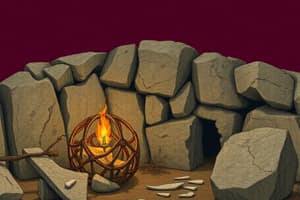Podcast
Questions and Answers
What marked the end of the Paleolithic period?
What marked the end of the Paleolithic period?
- The invention of pottery
- The development of permanent villages
- The beginning of agriculture
- The extinction of large mammals (correct)
Which tools were commonly used during the Mesolithic period?
Which tools were commonly used during the Mesolithic period?
- Polished stone tools for hunting (correct)
- Hand axes and adzes
- Advanced metal tools for farming
- Basic hunting tools made from wood
What was a significant lifestyle change that occurred during the Neolithic period?
What was a significant lifestyle change that occurred during the Neolithic period?
- The transition to permanent agriculture (correct)
- The introduction of advanced hunting tools
- Increased reliance on hunting and gathering
- Migration to cooler climates
What does the term 'Mesolithic' refer to?
What does the term 'Mesolithic' refer to?
During the Paleolithic period, what type of food did early humans primarily gather?
During the Paleolithic period, what type of food did early humans primarily gather?
What was a notable achievement of Sargon of Akkad?
What was a notable achievement of Sargon of Akkad?
What aspect of Gilgamesh's character is emphasized in his description?
What aspect of Gilgamesh's character is emphasized in his description?
What did Hammurabi's Code primarily address?
What did Hammurabi's Code primarily address?
Which kingdom faced decline shortly after Hammurabi's reign?
Which kingdom faced decline shortly after Hammurabi's reign?
By what year had the Assyrian Empire become the largest in the world?
By what year had the Assyrian Empire become the largest in the world?
Flashcards are hidden until you start studying
Study Notes
Stone Age Overview
- Paleolithic Period (Old Stone Age): Early humans were hunters and gatherers, living in caves or simple shelters, using basic tools for hunting, such as spears and stone knives.
- Cooking methods included roasting mammoths and gathering berries; this period also saw the first creation of art.
- The end of the Paleolithic coincided with the last Ice Age, causing massive extinctions, rising sea levels, and human migrations.
Mesolithic Period
- Timeframe: Approximately 10,000 B.C. to 8,000 B.C.
- Humans began using polished stone tools for weapons like spears and arrows.
- Nomadic lifestyles were prevalent, primarily near water sources; this period introduced agriculture leading to permanent village settlements.
Neolithic Period
- Timeframe: 8,000 B.C. to 3,000 B.C.
- Transition to agriculture with the domestication of animals and cultivation of crops.
- Utilization of advanced tools like hand axes and adzes for farming; significant developments in art, construction, pottery, sewing, and weaving occurred.
Epic of Gilgamesh
- One of the first literary works, composed of epic poems about Gilgamesh, the King of Uruk, who reigned around 2800 to 2500 B.C.
- Reflects on themes of life and mortality, exemplified in Gilgamesh's quote about searching for eternal life.
Babylon and Assyria
-
Babylon: Flourished under Hammurabi (1792 B.C.), who expanded its domain; notable for the Code of Hammurabi, one of the earliest written legal codes.
-
After Hammurabi's death (1750 B.C.), Babylon faced decline due to aggression from neighboring cultures including Hittites and Assyrians.
-
Assyria: Emerged from the city-state of Assur, becoming a dominant power by 671 B.C., with significant military conquests, including Egypt.
Archaeological Sites
- Ziggurat of Ur: A prominent Sumerian architectural site built around 2100 B.C., now in southern Iraq.
- Babylon: An ancient city founded around 5,000 years ago on the Euphrates River, renowned as a cultural and political center.
- Hattusha: An important Hittite site in Turkey preserved as a UNESCO World Heritage site.
- Persepolis: Ancient city in Iran known for its magnificent Persian architecture.
Ancient Mesopotamian Architecture
- Influenced by sociopolitical organization, religion, and natural environment; predominantly built using brick.
- Notable structures include the Ziggurat of Ur, showcasing advanced construction methods and religious significance.
Minoan and Mycenaean Architecture
- Palace of Knossos: A key Minoan complex with intricate layouts, constructed around 2000–1700 B.C., reflecting advanced urban planning.
- Mycenaean Civilization (c. 1700-1100 B.C.): Known for monumental palaces, fortified citadels, and tholos tombs, heavily influenced by earlier Minoan culture.
Parthian Empire
- Emerged around 247 B.C. following the fall of the Seleucid Empire, competing with Rome for dominance in various regions.
- Concluded around 224 C.E., paving the way for the Sasanian Empire; known for combining classical and indigenous architectural styles.
Hittites
- Occupied modern Turkey before 1700 B.C., building a powerful empire that contested Egyptian influence.
- Notable for their monumental architecture featuring cyclopean masonry and sculpture-laden gateways. Significant sites include Boğazköy.
Studying That Suits You
Use AI to generate personalized quizzes and flashcards to suit your learning preferences.




